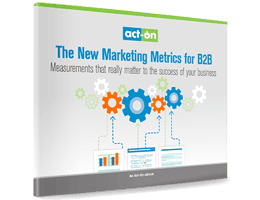Wikipedia: “Business intelligence (BI) is the set of techniques and tools for the transformation of raw data into meaningful and useful information for business analysis purposes.” The techniques range from strategies such as mapping business objectives to choosing which data to analyze. The tools include programs for data analysis, enterprise reporting, analytical processing, data visualization, and much more. Ashley Heath of Tour de Force gives us a primer for marketers:
Business intelligence (BI) means different things to different people, but at its core, business intelligence is all about acquiring the data in your organization that allows you to make intelligent decisions about all aspects of your business, from operations to sales to marketing.
Today we’re going to be talking specifically about how to leverage sales-based business intelligence. We’ve all heard the statistics: acquiring a new customer costs anywhere from 4 to 10 times as much as retaining an existing customer. The right BI solution will help you capitalize on the relationships that you already have with your existing customers to drive up-sells and deliver targeted marketing campaigns. Here are three ways that marketers can use sales-based business intelligence:
1. Use business intelligence to identify gaps or white spaces in your sales.
Instead of using BI to analyze what they are selling, smart marketers use BI to analyze what they’re NOT selling. Gap analysis features in BI solutions allow you to identify the whitespaces or gaps in sales by allowing a comparative analysis of different product groups that are being sold – or not sold.
Let’s assume that you’re a marketer at a company that sells food products. Using gap analysis, you can run a report to show you which of your ice cream shop customers are purchasing ice cream but not chocolate syrup. You know that the ice cream shops have to be getting their chocolate syrup from someone, but it apparently it isn’t you! Once you have this knowledge, you can create targeted marketing campaigns to those ice cream shops who aren’t buying your chocolate syrup to try to win that business from your competitors
2. Choose a system that provides actionable business intelligence and integration with other vital software systems.
BI solutions provide marketers with a wealth of information that can be used to drive sales and deliver effective marketing campaigns. As a marketer, you need to be able to take that information and use it to create next steps, whether those next steps are assigning follow-up tasks to the relevant sales person or launching an email or direct mail campaign.
A limitation of many BI systems is that it’s difficult to take any action from the BI system. You may be able to run an analysis on your customers to identify which accounts are at-risk and haven’t been purchasing from you, but in order to actually do anything with that information, you’re in for hands-on data manipulation between systems. All you have from your BI is a list of accounts. You then have to go into your CRM system to manually find each account and add those names to a marketing campaign. Depending on the size of your organization, this process may be highly impractical. Even for a company with a small customer list, it’s labor- and time-intensive, and an opportunity cost to other things you could be getting done.
The most efficient business intelligence solutions integrate with the other vital applications you use in your organization. Look for a solution that can easily share data with your CRM system, back office accounting or ERP system, marketing automation, or email marketing systems, etc., in order to allow you to analyze whatever data you need, and then take direct action from those results. As an example, you could run an at-risk customer analysis, identify customers who are buying less and then, with a few clicks, launch a highly targeted email campaign directly to the key contacts at those accounts.
3. Put business intelligence in the hands of your sales team.
 As marketers, our ultimate goal is to increase sales, and we can’t forget that one way of doing this is by improving our collaboration with our sales teams.
As marketers, our ultimate goal is to increase sales, and we can’t forget that one way of doing this is by improving our collaboration with our sales teams.
Many BI solutions have a flat reporting structure, meaning that analytics for the entire company are accessible by any user of the BI system. While this is an acceptable set-up for executives and for marketers who may need only to analyze the organization as a whole, many companies don’t provide their sales team with access … because they don’t want a salesperson to have access to other representatives’ sales numbers.
Enable your sales team with intelligence
But there’s no reason to hobble your sales team this way. A more effective business intelligence solution will be flexible enough to allow each organization to set up the system to match their existing sales structure. This way, each user sees only the information that’s relevant to them. Executives and marketers can see the entire organization, branch or territory managers see only the information from their regions, and sales people see only the information for their accounts.
Once you’re getting critical information into the hands of your sales team, marketing can begin collaborating with sales on business intelligence-inspired campaigns. Let’s go back again to the example of the food product company trying to figure out which ice cream shops aren’t purchasing their chocolate syrup. To begin, marketing runs the gap analysis to identify which accounts to target in the campaign. From those results, marketing launches a direct mail and email campaign with a discount promotion to try to win that chocolate syrup business.
Instead of stopping there, marketing can take this campaign one step further by asking that the inside sales team members personally follow up with each account to review the promotion and further explore what they can do to win the chocolate syrup business. Instead of marketing having to create spreadsheets or documents, forward those to the inside sales team and hope they find a way to use them, each sales representative simply needs to access their BI system and access the gap analysis that marketing has already set up. The system is configured to provide them access only to their own accounts, allowing them to effortlessly access their own list of accounts to target in the campaign. It’s faster; it’s easier; it’s more precise; and it increases the odds that the sales rep will make that call and get the business.
Marketers have always used business intelligence for market research and analysis, but it used to be a manual process involving paper and spreadsheets. With an effective sales-based business intelligence system, marketers can take a step closer to their current customers to identify missed opportunities and areas for potential growth, and share that actionable information with the sales team. It’s the kind of sales and marketing collaboration that builds alignment – and your bottom line.
Did you know? Ac t-On’s new Data Studio reporting capability has report templates that make it easy to answer common questions and gives you a solid starting point for more complex reports. It also lets you export BI-ready data, so you can add your marketing data to your other business intelligence and get a 360-degree view of your world.
t-On’s new Data Studio reporting capability has report templates that make it easy to answer common questions and gives you a solid starting point for more complex reports. It also lets you export BI-ready data, so you can add your marketing data to your other business intelligence and get a 360-degree view of your world.
Learn how to use data to analyze your buyer’s process, identify your marketing objectives at each stage, and measure your success. Find out what, when, why, and how to measure, with Act-On’s The New Marketing Metrics for B2B.

